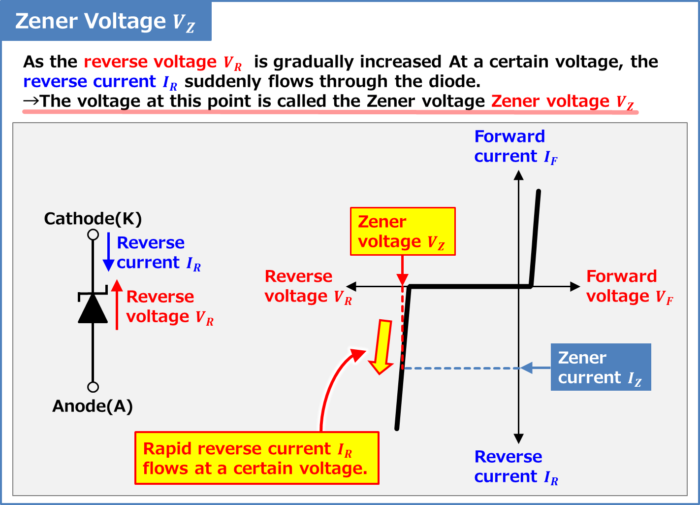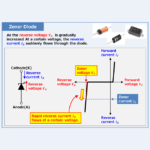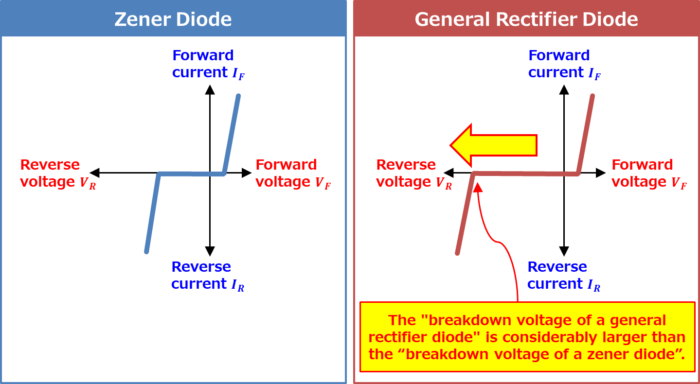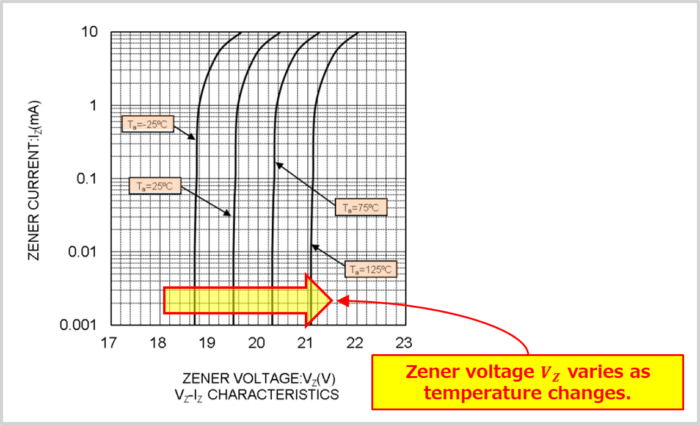Regarding the "Zener Voltage", this article will explain the information below.
- What is a Zener Voltage?
- Variation, Characteristics, and Temperature characteristics of zener voltage
What is a Zener Voltage?

If the reverse voltage \(V_R\) applied to the zener diode is gradually increased, a breakdown phenomenon occurs and current begins to flow rapidly at a certain point.
The reverse voltage \(V_R\) at which the reverse current \(I_R\) begins to flow rapidly is called the zener voltage (breakdown voltage) \(V_Z\). The reverse current \(I_R\) flowing at this time is called the zener current \(I_Z\).
In a zener diode, the zener voltage \(V_Z\) does not change much when the zener current \(I_Z\) changes. Zener diodes are often used in constant voltage circuits to take advantage of this characteristic.
Related article
The following article explains the "Zener Diode" in detail. If you are interested, please check it out from the link below. 続きを見る
What is a Zener Diode? How Does it Work?
Supplement


The "breakdown voltage of a general rectifier diode" is considerably larger than the "breakdown voltage of a zener diode".
Variation of Zener Voltage


The zener voltage \(V_Z\) of the zener diode is given in the datasheet.
The figure above shows part of the datasheet for ROHM's zener diodes (UDZV series). The zener voltage \(V_Z\) is shown when the zener current \(I_Z\) flows at 5mA.
The datasheet lists the minimum and maximum values of \(V_Z\). In the case of UDZV 20B, the minimum and maximum values of \(V_Z\) are 19.520V and 20.390V, respectively.
This means that the Zener voltage \(V_Z\) varies even within the same model number, and even under the same conditions, the Zener voltage \(V_Z\) may be 19.520V or 20.390V, depending on the individual product.
"Zener Current - Zener Voltage" Characteristics


On some datasheets, the characteristics of "vertical axis: Zener current \(I_Z\)" and "horizontal axis: Zener voltage \(V_Z\)" (\(I_Z\)-\(V_Z\) characteristics) are described. The above figure shows the "\(I_Z\)-\(V_Z\) characteristics" of a ROHM-made zener diode (UDZV 20B).
The "\(I_Z\)-\(V_Z\) characteristic" shows how much the zener voltage \(V_Z\) changes when the zener current \(I_Z\) changes.
The "\(I_Z\)-\(V_Z\) Characteristics" also shows that the zener voltage \(V_Z\) varies depending on the ambient temperature Ta. In the case of "UDZV 20B," the zener voltage \(V_Z\) increases as the ambient temperature Ta rises.
Next, the temperature characteristics of the Zener voltage \(V_Z\) are explained.
Temperature Characteristics of Zener Voltage


Depending on the magnitude of the zener voltage, a zener diode may have a positive or negative temperature coefficient.
Those with a Zener voltage higher than around 5V have a positive temperature coefficient, so the zener voltage increases as the temperature rises.
On the other hand, those whose zener voltage is lower than around 5V have a negative temperature coefficient, so the zener voltage decreases as the temperature rises.
In addition, the positive and negative temperature coefficients cancel each other for zener diodes with a zener voltage near 5V, resulting in a small temperature change.
Related article
The following article explains the "Temperature Characteristics of Zener Diode" in detail. If you are interested, please check it out from the link below. 続きを見る


Temperature Coefficient of Zener Diode
Summary
In this article, the following information on the "Zener Diode" was explained.
- What is a Zener Voltage?
- Variation, Characteristics, and Temperature characteristics of zener voltage
Thank you for reading.
Related article
"Information about Zener diodes" is explained in detail in the following articles. If you are interested, please check it out from the link below.